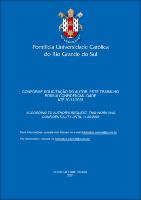| Share record |


|
Please use this identifier to cite or link to this item:
https://tede2.pucrs.br/tede2/handle/tede/9981Full metadata record
| DC Field | Value | Language |
|---|---|---|
| dc.creator | Valenzuela, Eneida Beatriz Sanfelice | - |
| dc.creator.Lattes | http://lattes.cnpq.br/8616634625060319 | por |
| dc.contributor.advisor1 | Spohr, Ana Maria | - |
| dc.contributor.advisor1Lattes | http://lattes.cnpq.br/9374309741859850 | por |
| dc.date.accessioned | 2021-11-30T17:27:34Z | - |
| dc.date.issued | 2020-02-26 | - |
| dc.identifier.uri | http://tede2.pucrs.br/tede2/handle/tede/9981 | - |
| dc.description.resumo | O objetivo do estudo, in vitro, foi avaliar a resistência à fratura de restaurações cerâmicas IPS e.max CAD confeccionadas pela técnica CAD/CAM (Computer-aided desing/Computer-aided manufacturing) em espessuras ultrafinas (0,3 mm 0,6 mm), cimentadas em substratos de esmalte ou dentina. Cinquenta molares humanos foram divididos randomicamente em cinco grupos (n=10): G1 – dentes hígidos (controle) ; G2 – espessura da restauração de 0,3 mm cimentada em esmalte; G3 – restauração com 0.6 mm cimentada em esmalte; G4 – restauração com 0,3 mm cimentada em dentina; G5 – restauração com 0,6 mm cimentada em dentina. A cimentação foi realizada em esmalte ou dentina pela técnica adesiva, sendo armazenadas em água destilada a 37ºC por 24 h. Após armazenagem, as amostras foram submetidas à ciclagem mecânica (1.000.000 de ciclos com carga de 200 N). Na sequência, foi realizado o teste de resistência à fratura em máquina de ensaio universal com velocidade de carregamento de 1 mm/minuto. As fraturas foram classificadas como reparáveis e irreparáveis. De acordo com a Análise de Variância de duas vias, apenas o efeito da espessura das restaurações foi significativo (p = 0,002). De acordo com o teste de Tukey, médias seguidas de letras distintas diferem estatisticamente entre si (p<0,05): G1 (3204 N)ab; G2 (3144 N)ab; G3 (2489 N)b; G4 (3591 N)a; G5 (2770 N)ab. As falhas foram irreparáveis no grupo controle, havendo falhas reparáveis e irreparáveis nos grupos experimentais. Concluiu-se que as restaurações ultrafinas, cimentadas em esmalte como em dentina, obtiveram resistência à fratura comparáveis ao do dente hígido. | por |
| dc.description.abstract | The aim of the study was to evaluate, in vitro, the fracture resistance of occlusal veneers, made by CAD/CAM, with IPS e.max CAD material in thicknesses of 0.6 mm and 0.3 mm bonded to enamel and dentin. Fifty human molars were randomly divided into five groups (n=10): G1 – sound teeth (control); G2 – veneer thickness with 0,3 mm bonded to enamel; G3 – veneer thickness with 0,6 mm bonded to enamel; G4 – veneer thickness with 0,3 mm bonded to dentin; G5 – veneer thickness with 0,6 mm bonded to dentin. The venners were adhesively luted to enamel or dentin and stored in distilled water for 24 hours. After storage, the samples were submitted to mechanical cyclic loading (1 million cycles at 200 N load). After that, the fracture resistance test was performed in a universal testing machine with crosshead speed of 1 mm/minute. The fractures were classificate as reparable and irreparable. Accoding to two-way analysis of variance (ANOVA), only veneers thickness factor was significant (p=0,002). According to Tukey test, means followed by diferent letters represent significant diferences (p<0.05): G1 (3204 N)ab; G2 (3144 N)ab ; G3 (2489 N)b ; G4 (3591 N)a; G5 (2770 N)ab. In the control group the failures were irreparable and in the experimental groups there were reparable and irreparable failures. It was concluded that ultrathin occlusal veneers, luted to enamel or dentin, obtained fracture resistance comparable to that of the sound tooth. | eng |
| dc.description.provenance | Submitted by PPG Odontologia ([email protected]) on 2021-11-29T19:14:41Z No. of bitstreams: 1 ENEIDA_BEATRIZ_SANFELICE_VALENZUELA_DIS.pdf: 427498 bytes, checksum: b54e35b0a55a5cc8a3442f95775af5b5 (MD5) | eng |
| dc.description.provenance | Approved for entry into archive by Caroline Xavier ([email protected]) on 2021-11-30T17:20:28Z (GMT) No. of bitstreams: 1 ENEIDA_BEATRIZ_SANFELICE_VALENZUELA_DIS.pdf: 427498 bytes, checksum: b54e35b0a55a5cc8a3442f95775af5b5 (MD5) | eng |
| dc.description.provenance | Made available in DSpace on 2021-11-30T17:27:34Z (GMT). No. of bitstreams: 1 ENEIDA_BEATRIZ_SANFELICE_VALENZUELA_DIS.pdf: 427498 bytes, checksum: b54e35b0a55a5cc8a3442f95775af5b5 (MD5) Previous issue date: 2020-02-26 | eng |
| dc.description.sponsorship | Coordenação de Aperfeiçoamento de Pessoal de Nível Superior - CAPES | por |
| dc.format | application/pdf | * |
| dc.thumbnail.url | http://tede2.pucrs.br:80/tede2/retrieve/182737/DIS_ENEIDA_BEATRIZ_SANFELICE_VALENZUELA_CONFIDENCIAL.pdf.jpg | * |
| dc.language | por | por |
| dc.publisher | Pontifícia Universidade Católica do Rio Grande do Sul | por |
| dc.publisher.department | Escola de Ciências da Saúde e da Vida | por |
| dc.publisher.country | Brasil | por |
| dc.publisher.initials | PUCRS | por |
| dc.publisher.program | Programa de Pós-Graduação em Odontologia | por |
| dc.rights | Acesso Aberto | por |
| dc.subject | Cerâmica | por |
| dc.subject | Resistência à fratura | por |
| dc.subject | Esmalte | por |
| dc.subject | Dentina | por |
| dc.subject | Ceramic | eng |
| dc.subject | Fracture resistance | eng |
| dc.subject | Enamel | eng |
| dc.subject | Dentin | eng |
| dc.subject.cnpq | CIENCIAS DA SAUDE:ODONTOLOGIA | por |
| dc.title | Resistência à fratura de facetas oclusais ultrafinas confeccionadas em CAD/CAM e cimentadas em esmalte e dentina | por |
| dc.type | Dissertação | por |
| dc.restricao.situacao | Trabalho será publicado como artigo ou livro | por |
| dc.restricao.prazo | 60 meses | por |
| dc.restricao.dataliberacao | 30/11/2026 | por |
| Appears in Collections: | Programa de Pós-Graduação em Odontologia | |
Files in This Item:
| File | Description | Size | Format | |
|---|---|---|---|---|
| DIS_ENEIDA_BEATRIZ_SANFELICE_VALENZUELA_CONFIDENCIAL.pdf | ENEIDA_BEATRIZ_SANFELICE_VALENZUELA_DIS | 307.57 kB | Adobe PDF |  Download/Open Preview |
Items in DSpace are protected by copyright, with all rights reserved, unless otherwise indicated.




